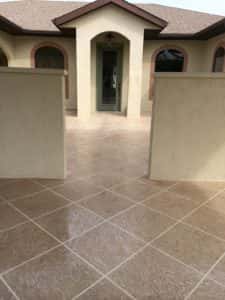
Waterproofing Under Tile: Why it’s Important & Commonly Overlooked
Using tile can enhance the aesthetic value of your deck or flooring, though what looks good always has risks. Just like using plywood or concrete to improve your deck’s appearance, you need some protection to prevent deterioration from natural elements.
It’s here where waterproofing is essential. Maybe you’ve already placed tile on your deck or flooring this year and didn’t bother to place a waterproofing coating underneath. This was a mistake because having a base coating protects from a number of things potentially ruining your floor.
Unfortunately, a lot of people frequently overlook placing waterproofing under tile. The reason is perhaps everything to do with impatience.
Waterproofing doesn’t take long to apply. The consequences for not applying it under tile first can cost you more money down the road.
Tile is a Porous Material
One thing to learn about tile is it’s porous, meaning moisture can seep through and create deterioration issues later. If you use tile on a rooftop deck in a rainy climate, this can quickly become a major problem. The same applies to tile used for indoor flooring, especially around showers.
Ultimately, when moisture seeps through the tiles, mold is inevitable. Although it’s not the only concern, particularly on decks where deterioration often turns into a snowball effect.
Always remember that even water vapors cause the same issues. It means you need to choose your waterproofing membrane carefully during application.
You may need special membranes and bonding agents to provide extra layers of protection.
Measuring Your Climate
Before applying your waterproofing coating under tile, study your local climate to see how much protection you need. You may want additional layers of membrane if you live in an overly rainy climate, like the U.S. Northwest.
In most cases, you’ll have to go beyond measuring rainfall and analyze other common weather issues. UV light and humidity fluctuations can cause problems with your tile if not properly waterproofed.
With tile being applied directly over fluid applications and sheet membranes (using a thinset method), waterproofing doesn’t take long. It works even better when using a one-ply coating to save you further time.
Assuming time is one reason behind so many ignoring tile waterproofing, what other reasons are there behind this being overlooked?
Other Reasons for Overlooking Tile Protection
Some people create assumptions that tile can penetrate moisture. As strong as tile looks, appearances are always deceiving. It’s why you need a professional flooring expert to show you how much protection your tile requires.
Don’t assume tile is going to stay protected indoors either. Water vapors could easily get into any room, including your basement. Just a small amount of water (like a leak) could get into the tile pores and create mold.
The last thing you want is mold to start forming, which could become detrimental to your health when in your living spaces.
Further Consequences if Not Protecting Your Tile
While mold is a given, other issues could occur relating to one another. With mold, you may attract termites or carpenter ants, all of which become highly destructive within your home.
Eventually, mold or deterioration could become so severe, you’ll have to replace all your floor tiles. Having this occur less than a few years after putting them in can become a needless expense. Even if you get it right the second time, you’ll always be out your original investment.
The same can easily happen with your deck, particularly if you use plywood or concrete under tiles.
At Pli-Dek Systems, we’ve created a unique waterproof coating system to protect tiles on any floor.
Contact us to learn more about the components of our product and other specialty coatings.











